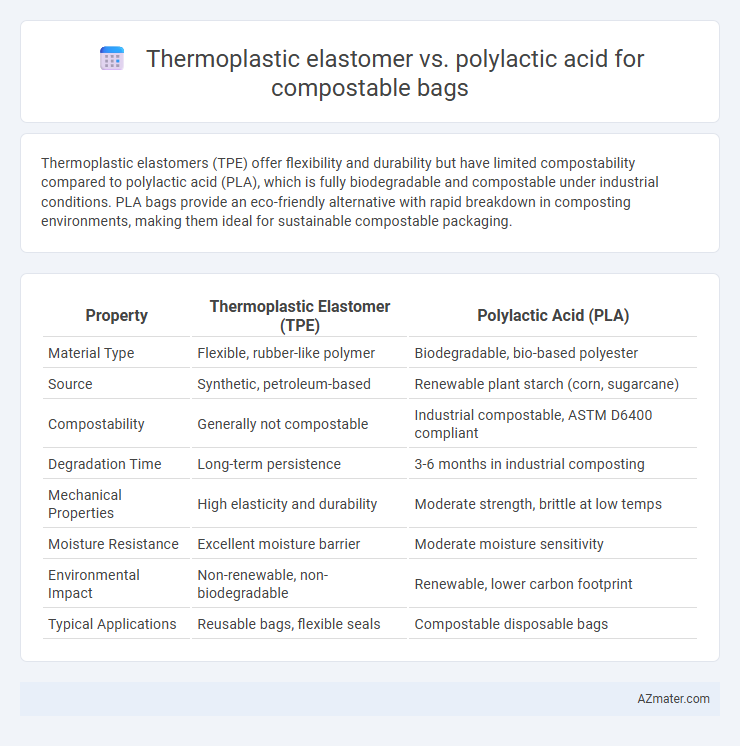Thermoplastic elastomers (TPE) offer flexibility and durability but have limited compostability compared to polylactic acid (PLA), which is fully biodegradable and compostable under industrial conditions. PLA bags provide an eco-friendly alternative with rapid breakdown in composting environments, making them ideal for sustainable compostable packaging.
Table of Comparison
| Property | Thermoplastic Elastomer (TPE) | Polylactic Acid (PLA) |
|---|---|---|
| Material Type | Flexible, rubber-like polymer | Biodegradable, bio-based polyester |
| Source | Synthetic, petroleum-based | Renewable plant starch (corn, sugarcane) |
| Compostability | Generally not compostable | Industrial compostable, ASTM D6400 compliant |
| Degradation Time | Long-term persistence | 3-6 months in industrial composting |
| Mechanical Properties | High elasticity and durability | Moderate strength, brittle at low temps |
| Moisture Resistance | Excellent moisture barrier | Moderate moisture sensitivity |
| Environmental Impact | Non-renewable, non-biodegradable | Renewable, lower carbon footprint |
| Typical Applications | Reusable bags, flexible seals | Compostable disposable bags |
Introduction to Compostable Bags
Thermoplastic elastomers (TPE) and polylactic acid (PLA) are key materials used in the production of compostable bags, each offering distinct properties crucial for biodegradability. PLA, derived from renewable resources like corn starch, provides excellent compostability under industrial conditions, breaking down into water, carbon dioxide, and biomass. TPE offers flexibility and durability but may require enhanced formulations to meet compostability standards, making PLA a more established choice for eco-friendly disposable bags.
Overview of Thermoplastic Elastomer (TPE)
Thermoplastic elastomers (TPE) combine the elasticity of rubber with the processing advantages of plastics, making them flexible, durable, and recyclable materials suitable for various applications, including bags. TPEs are synthetic polymers that can be repeatedly melted and reshaped without losing their mechanical properties, distinguishing them from traditional elastomers that require vulcanization. Their versatility and resistance to wear make TPEs an effective choice for reusable bags, although they are less readily compostable compared to bioplastics like polylactic acid (PLA).
Overview of Polylactic Acid (PLA)
Polylactic Acid (PLA) is a biodegradable thermoplastic derived from renewable resources such as corn starch or sugarcane, making it an eco-friendly alternative to traditional plastics in compostable bags. PLA offers excellent clarity and stiffness but has limited heat resistance and flexibility compared to Thermoplastic Elastomers (TPE). Its compostability under industrial composting conditions and renewable origin position PLA as a leading material in sustainable packaging solutions.
Material Composition and Sources
Thermoplastic elastomers (TPE) are synthetic polymers combining rubbery elasticity with thermoplastic processability, primarily derived from petrochemical sources, which limits their biodegradability in compostable bags. Polylactic acid (PLA) is a biopolymer synthesized from renewable resources like corn starch or sugarcane, offering inherent compostability due to its bio-based, aliphatic polyester composition. The material composition of PLA ensures it breaks down under industrial composting conditions, whereas TPE's synthetic hydrocarbon chains resist microbial degradation, affecting suitability for eco-friendly bag applications.
Biodegradability and Compostability Compare
Thermoplastic elastomer (TPE) offers flexibility and durability but typically exhibits slower biodegradability compared to polylactic acid (PLA), which is derived from renewable resources and rapidly breaks down in industrial composting environments. PLA compostable bags comply with standards like ASTM D6400, ensuring complete decomposition within 90 to 180 days under controlled conditions, while TPE bags may require extended times and specific microbial activity to achieve similar results. Choosing PLA enhances environmental benefits by maximizing compostability and reducing persistent plastic residues in soil ecosystems.
Strength and Durability Analysis
Thermoplastic elastomers (TPE) exhibit superior strength and elasticity compared to polylactic acid (PLA), making them more resistant to tearing and impact for compostable bag applications. PLA offers biodegradability but tends to have lower tensile strength and brittleness, limiting durability under stress and repeated use. Strength and durability assessments favor TPE for heavy-duty compostable bags requiring flexibility, while PLA suits lighter, single-use options with enhanced environmental degradation.
Environmental Impact of TPE vs PLA
Thermoplastic elastomers (TPE) have limited compostability due to their synthetic polymer structure, leading to slower degradation and potential microplastic pollution. Polylactic acid (PLA), derived from renewable resources like corn starch, breaks down more efficiently in industrial composting facilities, significantly reducing landfill waste and greenhouse gas emissions. However, PLA requires specific composting conditions not met by all municipal systems, whereas TPE's environmental persistence raises concerns about long-term ecological impact.
Cost and Manufacturing Considerations
Thermoplastic elastomers (TPE) generally offer greater flexibility and durability for compostable bags but come with higher raw material costs and more complex processing techniques compared to polylactic acid (PLA). PLA benefits from lower production costs, renewable sourcing from corn starch or sugarcane, and easier thermoforming, making it more scalable for large-volume manufacturing. Manufacturing considerations must balance TPE's enhanced mechanical properties against PLA's cost efficiency and biodegradability, influencing material selection based on end-use application and budget constraints.
End-of-Life Scenarios and Recycling
Thermoplastic elastomers (TPEs) offer flexibility and durability but present challenges in end-of-life scenarios due to their complex polymer blends, making recycling difficult and often leading to landfill disposal. Polylactic acid (PLA), derived from renewable resources, is industrially compostable under controlled conditions, providing a more eco-friendly end-of-life option for compostable bags. However, PLA's biodegradability is limited in typical home composting environments, requiring specialized facilities to ensure effective degradation and reduce environmental impact.
Choosing the Ideal Material for Compostable Bags
Thermoplastic elastomers (TPE) offer flexibility and durability but often lack full compostability, making them less ideal for compostable bags compared to polylactic acid (PLA), which is a bioplastic derived from renewable resources like corn starch and is fully compostable under industrial conditions. PLA's biodegradability and lower environmental footprint align better with sustainable packaging goals, providing an eco-friendly alternative to traditional plastics. For compostable bags, PLA's certification standards such as ASTM D6400 and EN 13432 ensure that the material breaks down efficiently in composting environments, promoting soil health and reducing plastic waste.

Infographic: Thermoplastic elastomer vs Polylactic acid for Compostable bag
 azmater.com
azmater.com